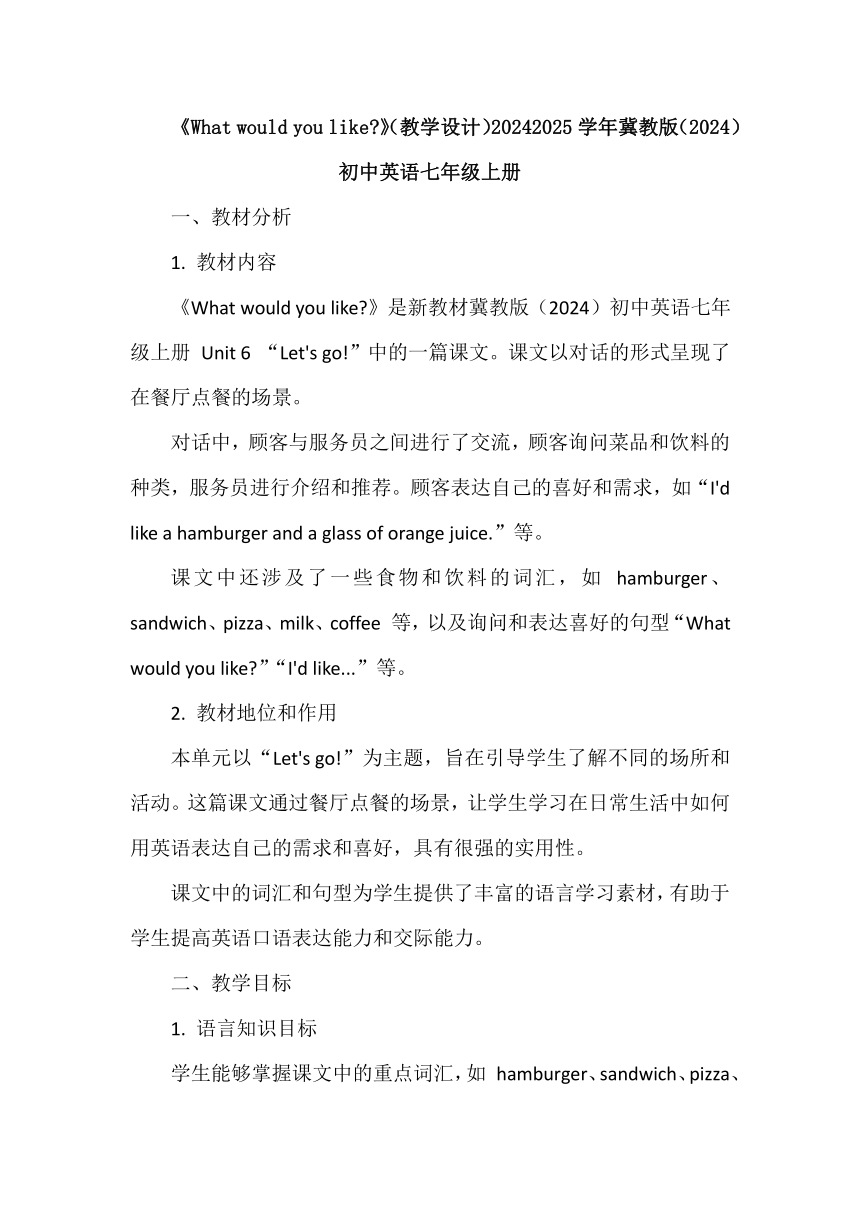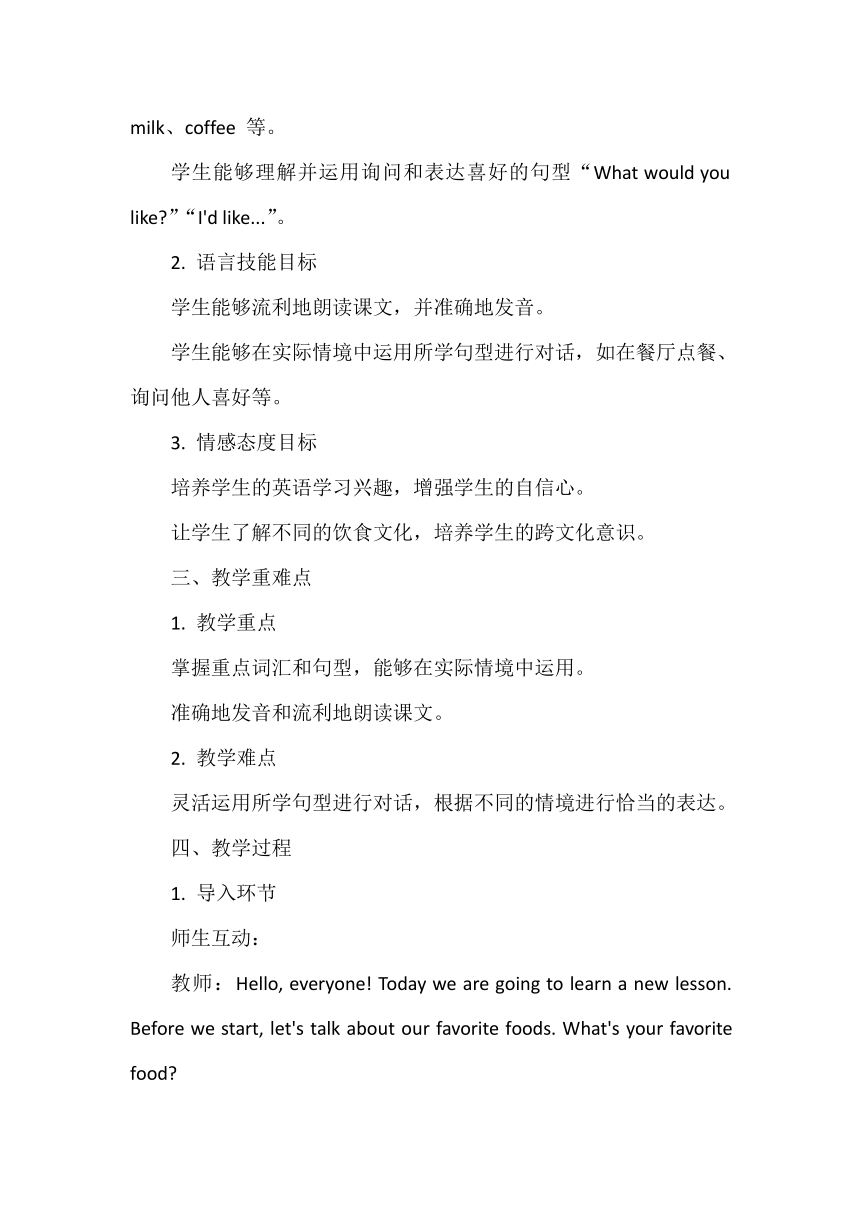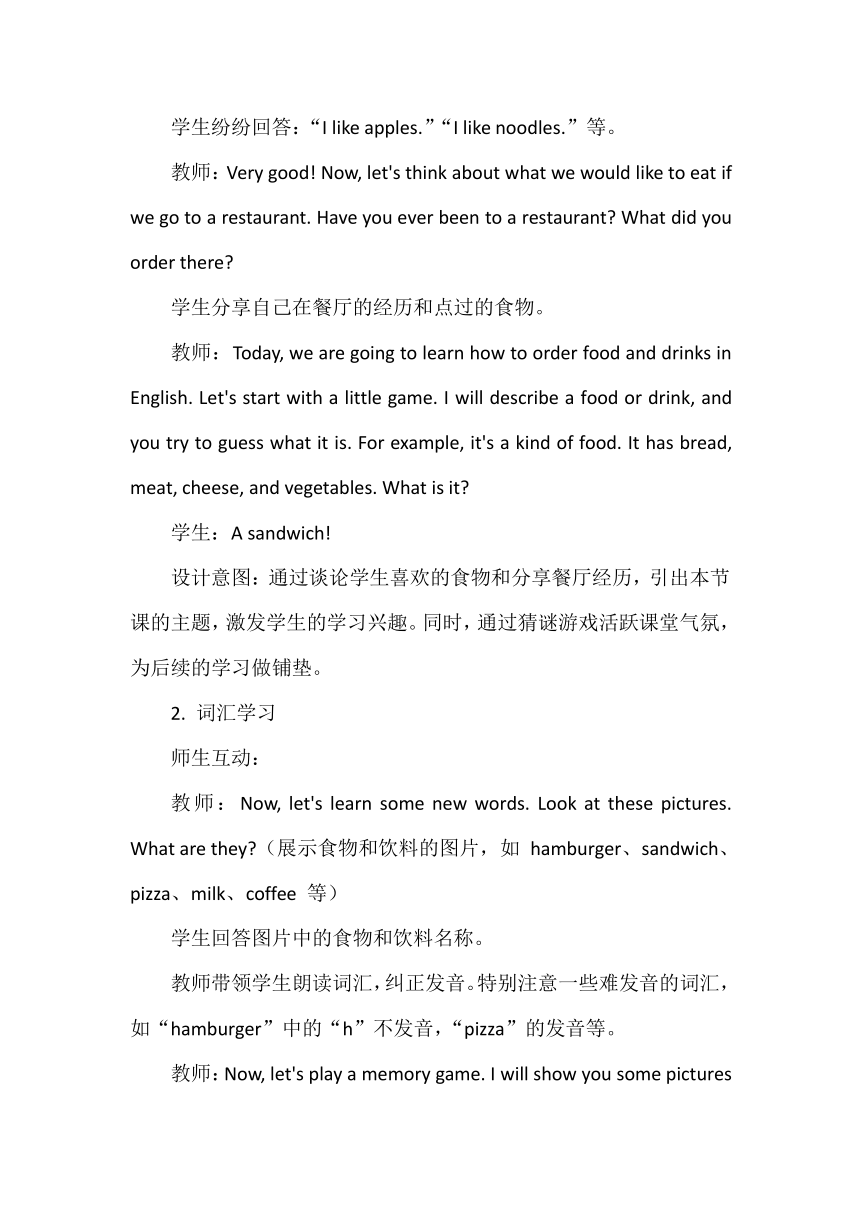Unit 6 Lesson 4 What would you like (教学设计) 冀教版(2024)初中英语七年级上册
文档属性
| 名称 | Unit 6 Lesson 4 What would you like (教学设计) 冀教版(2024)初中英语七年级上册 |  | |
| 格式 | docx | ||
| 文件大小 | 19.9KB | ||
| 资源类型 | 教案 | ||
| 版本资源 | 冀教版 | ||
| 科目 | 英语 | ||
| 更新时间 | 2024-10-10 08:03:46 | ||
图片预览




文档简介
《What would you like 》(教学设计)20242025学年冀教版(2024)初中英语七年级上册
一、教材分析
1. 教材内容
《What would you like 》是新教材冀教版(2024)初中英语七年级上册 Unit 6 “Let's go!”中的一篇课文。课文以对话的形式呈现了在餐厅点餐的场景。
对话中,顾客与服务员之间进行了交流,顾客询问菜品和饮料的种类,服务员进行介绍和推荐。顾客表达自己的喜好和需求,如“I'd like a hamburger and a glass of orange juice.”等。
课文中还涉及了一些食物和饮料的词汇,如 hamburger、sandwich、pizza、milk、coffee 等,以及询问和表达喜好的句型“What would you like ”“I'd like...”等。
2. 教材地位和作用
本单元以“Let's go!”为主题,旨在引导学生了解不同的场所和活动。这篇课文通过餐厅点餐的场景,让学生学习在日常生活中如何用英语表达自己的需求和喜好,具有很强的实用性。
课文中的词汇和句型为学生提供了丰富的语言学习素材,有助于学生提高英语口语表达能力和交际能力。
二、教学目标
1. 语言知识目标
学生能够掌握课文中的重点词汇,如 hamburger、sandwich、pizza、milk、coffee 等。
学生能够理解并运用询问和表达喜好的句型“What would you like ”“I'd like...”。
2. 语言技能目标
学生能够流利地朗读课文,并准确地发音。
学生能够在实际情境中运用所学句型进行对话,如在餐厅点餐、询问他人喜好等。
3. 情感态度目标
培养学生的英语学习兴趣,增强学生的自信心。
让学生了解不同的饮食文化,培养学生的跨文化意识。
三、教学重难点
1. 教学重点
掌握重点词汇和句型,能够在实际情境中运用。
准确地发音和流利地朗读课文。
2. 教学难点
灵活运用所学句型进行对话,根据不同的情境进行恰当的表达。
四、教学过程
1. 导入环节
师生互动:
教师:Hello, everyone! Today we are going to learn a new lesson. Before we start, let's talk about our favorite foods. What's your favorite food
学生纷纷回答:“I like apples.”“I like noodles.”等。
教师:Very good! Now, let's think about what we would like to eat if we go to a restaurant. Have you ever been to a restaurant What did you order there
学生分享自己在餐厅的经历和点过的食物。
教师:Today, we are going to learn how to order food and drinks in English. Let's start with a little game. I will describe a food or drink, and you try to guess what it is. For example, it's a kind of food. It has bread, meat, cheese, and vegetables. What is it
学生:A sandwich!
设计意图:通过谈论学生喜欢的食物和分享餐厅经历,引出本节课的主题,激发学生的学习兴趣。同时,通过猜谜游戏活跃课堂气氛,为后续的学习做铺垫。
2. 词汇学习
师生互动:
教师:Now, let's learn some new words. Look at these pictures. What are they (展示食物和饮料的图片,如 hamburger、sandwich、pizza、milk、coffee 等)
学生回答图片中的食物和饮料名称。
教师带领学生朗读词汇,纠正发音。特别注意一些难发音的词汇,如“hamburger”中的“h”不发音,“pizza”的发音等。
教师:Now, let's play a memory game. I will show you some pictures for a few seconds, and then you have to remember as many food and drink items as possible.
展示图片后,学生回忆并说出看到的食物和饮料名称。
教师:Let's also learn some adjectives to describe these foods. For example, “delicious”, “tasty”, “yummy”. Can you use these adjectives to describe the foods you like
学生:I like hamburgers. They are delicious. / I think pizza is tasty.
设计意图:通过图片展示、记忆游戏和学习形容词,让学生多方面地掌握新词汇,提高词汇学习的趣味性和效果。
3. 句型学习
师生互动:
教师:Now that we know some words about food and drinks, let's learn some sentences. Look at this dialogue.(展示课文中的对话)What are they saying
学生阅读对话,理解对话内容。
教师讲解句型“What would you like ”“I'd like...”的用法,并强调这是一种礼貌的询问和表达喜好的方式。
教师与学生进行对话练习,如:
Teacher: What would you like
Student: I'd like a hamburger.
Teacher: What would you like to drink
Student: I'd like a glass of milk.
教师引导学生进行拓展练习,如:
Teacher: What else would you like
Student: I'd like some fries.
Teacher: Are you sure That's a lot of food.
Student: Yes, I'm very hungry.
设计意图:通过对话学习句型,让学生在实际情境中理解和运用句型。拓展练习可以帮助学生更好地掌握句型的灵活运用。
4. 课文学习
师生互动:
教师:Now, let's read the text together. Pay attention to your pronunciation and intonation.(带领学生朗读课文)
学生分角色朗读课文。可以让学生自愿扮演顾客和服务员的角色,增强参与感。
教师提问:What does the customer want to eat What does the customer want to drink (引导学生理解课文内容)
学生回答问题。
教师进一步提问:Why does the customer choose these foods and drinks What do you think of the customer's choices
学生思考并回答问题,培养学生的分析和评价能力。
设计意图:通过朗读课文,让学生熟悉课文内容,提高口语表达能力。提问环节加深学生对课文的理解,同时引导学生进行思考和评价。
5. 对话练习
师生互动:
教师:Now, let's practice making dialogues. Suppose you are in a restaurant. What would you like to eat and drink Work in pairs and make a dialogue.(学生分组进行对话练习)
教师巡视并给予指导,帮助学生解决在对话中遇到的问题。
几组学生进行对话表演,其他学生认真听,并给予评价。评价可以包括发音是否准确、语法是否正确、对话是否流畅等方面。
教师:Very good! You did a great job. Now, let's change the situation. Suppose you are having a picnic. What would you like to bring Make a dialogue again.(学生再次进行对话练习)
教师可以引导学生在对话中加入一些理由和描述,如“Why do you want to bring this food ”“This food is easy to carry and delicious.”等。
设计意图:通过不同的情境进行对话练习,让学生灵活运用所学句型,提高口语交际能力。评价环节可以促进学生之间的学习和交流。
6. 拓展延伸
师生互动:
教师:Now, let's learn some more expressions about food and drinks. For example, “I'm hungry. I want something to eat.” “I'm thirsty. I want something to drink.”(教授一些拓展的表达)
教师:Can you think of other expressions (引导学生思考并分享其他相关表达)
学生分享自己想到的表达,如“I love pizza.”“I don't like coffee.”“This drink is too sweet.”等。
教师介绍一些不同国家的特色美食和饮品,如“French fries are popular in America.”“Sushi is a famous Japanese food.”等,拓展学生的文化视野。
设计意图:拓展学生的语言表达,丰富学生的词汇和句型。同时,介绍不同国家的美食和饮品可以培养学生的跨文化意识。
7. 总结归纳
师生互动:
教师:Today we learned some new words and sentences about food and drinks. Who can tell me what we learned
学生回顾所学内容,回答问题。
教师:Very good! Remember, when we ask for something, we can use “What would you like ” And when we answer, we can use “I'd like...” Also, we learned many different foods and drinks. We can use adjectives to describe them. And we know some expressions about being hungry and thirsty.
教师布置作业:Write a short dialogue about ordering food in a restaurant or preparing for a picnic. Use the words and sentences we learned today.
设计意图:通过总结归纳,让学生巩固所学知识,明确重点内容。作业布置可以让学生进一步巩固所学知识,提高语言运用能力。
五、课堂练习
1. 词汇填空
I'd like a _hamburger_ and a glass of _milk_.
What would you like to eat I'd like a _sandwich_.
2. 句型转换
I'd like some pizza.(改为一般疑问句)
Would you like some pizza
What would you like to drink (用“I'd like a cup of coffee.”回答)
I'd like a cup of coffee.
3. 情景对话
You are in a restaurant. Make a dialogue with your partner about what you would like to eat and drink.
六、板书设计
What would you like
1. Vocabulary: hamburger, sandwich, pizza, milk, coffee...
Adjectives: delicious, tasty, yummy
2. Sentences: What would you like
I'd like...
What else would you like
I'm hungry/thirsty. I want...
一、教材分析
1. 教材内容
《What would you like 》是新教材冀教版(2024)初中英语七年级上册 Unit 6 “Let's go!”中的一篇课文。课文以对话的形式呈现了在餐厅点餐的场景。
对话中,顾客与服务员之间进行了交流,顾客询问菜品和饮料的种类,服务员进行介绍和推荐。顾客表达自己的喜好和需求,如“I'd like a hamburger and a glass of orange juice.”等。
课文中还涉及了一些食物和饮料的词汇,如 hamburger、sandwich、pizza、milk、coffee 等,以及询问和表达喜好的句型“What would you like ”“I'd like...”等。
2. 教材地位和作用
本单元以“Let's go!”为主题,旨在引导学生了解不同的场所和活动。这篇课文通过餐厅点餐的场景,让学生学习在日常生活中如何用英语表达自己的需求和喜好,具有很强的实用性。
课文中的词汇和句型为学生提供了丰富的语言学习素材,有助于学生提高英语口语表达能力和交际能力。
二、教学目标
1. 语言知识目标
学生能够掌握课文中的重点词汇,如 hamburger、sandwich、pizza、milk、coffee 等。
学生能够理解并运用询问和表达喜好的句型“What would you like ”“I'd like...”。
2. 语言技能目标
学生能够流利地朗读课文,并准确地发音。
学生能够在实际情境中运用所学句型进行对话,如在餐厅点餐、询问他人喜好等。
3. 情感态度目标
培养学生的英语学习兴趣,增强学生的自信心。
让学生了解不同的饮食文化,培养学生的跨文化意识。
三、教学重难点
1. 教学重点
掌握重点词汇和句型,能够在实际情境中运用。
准确地发音和流利地朗读课文。
2. 教学难点
灵活运用所学句型进行对话,根据不同的情境进行恰当的表达。
四、教学过程
1. 导入环节
师生互动:
教师:Hello, everyone! Today we are going to learn a new lesson. Before we start, let's talk about our favorite foods. What's your favorite food
学生纷纷回答:“I like apples.”“I like noodles.”等。
教师:Very good! Now, let's think about what we would like to eat if we go to a restaurant. Have you ever been to a restaurant What did you order there
学生分享自己在餐厅的经历和点过的食物。
教师:Today, we are going to learn how to order food and drinks in English. Let's start with a little game. I will describe a food or drink, and you try to guess what it is. For example, it's a kind of food. It has bread, meat, cheese, and vegetables. What is it
学生:A sandwich!
设计意图:通过谈论学生喜欢的食物和分享餐厅经历,引出本节课的主题,激发学生的学习兴趣。同时,通过猜谜游戏活跃课堂气氛,为后续的学习做铺垫。
2. 词汇学习
师生互动:
教师:Now, let's learn some new words. Look at these pictures. What are they (展示食物和饮料的图片,如 hamburger、sandwich、pizza、milk、coffee 等)
学生回答图片中的食物和饮料名称。
教师带领学生朗读词汇,纠正发音。特别注意一些难发音的词汇,如“hamburger”中的“h”不发音,“pizza”的发音等。
教师:Now, let's play a memory game. I will show you some pictures for a few seconds, and then you have to remember as many food and drink items as possible.
展示图片后,学生回忆并说出看到的食物和饮料名称。
教师:Let's also learn some adjectives to describe these foods. For example, “delicious”, “tasty”, “yummy”. Can you use these adjectives to describe the foods you like
学生:I like hamburgers. They are delicious. / I think pizza is tasty.
设计意图:通过图片展示、记忆游戏和学习形容词,让学生多方面地掌握新词汇,提高词汇学习的趣味性和效果。
3. 句型学习
师生互动:
教师:Now that we know some words about food and drinks, let's learn some sentences. Look at this dialogue.(展示课文中的对话)What are they saying
学生阅读对话,理解对话内容。
教师讲解句型“What would you like ”“I'd like...”的用法,并强调这是一种礼貌的询问和表达喜好的方式。
教师与学生进行对话练习,如:
Teacher: What would you like
Student: I'd like a hamburger.
Teacher: What would you like to drink
Student: I'd like a glass of milk.
教师引导学生进行拓展练习,如:
Teacher: What else would you like
Student: I'd like some fries.
Teacher: Are you sure That's a lot of food.
Student: Yes, I'm very hungry.
设计意图:通过对话学习句型,让学生在实际情境中理解和运用句型。拓展练习可以帮助学生更好地掌握句型的灵活运用。
4. 课文学习
师生互动:
教师:Now, let's read the text together. Pay attention to your pronunciation and intonation.(带领学生朗读课文)
学生分角色朗读课文。可以让学生自愿扮演顾客和服务员的角色,增强参与感。
教师提问:What does the customer want to eat What does the customer want to drink (引导学生理解课文内容)
学生回答问题。
教师进一步提问:Why does the customer choose these foods and drinks What do you think of the customer's choices
学生思考并回答问题,培养学生的分析和评价能力。
设计意图:通过朗读课文,让学生熟悉课文内容,提高口语表达能力。提问环节加深学生对课文的理解,同时引导学生进行思考和评价。
5. 对话练习
师生互动:
教师:Now, let's practice making dialogues. Suppose you are in a restaurant. What would you like to eat and drink Work in pairs and make a dialogue.(学生分组进行对话练习)
教师巡视并给予指导,帮助学生解决在对话中遇到的问题。
几组学生进行对话表演,其他学生认真听,并给予评价。评价可以包括发音是否准确、语法是否正确、对话是否流畅等方面。
教师:Very good! You did a great job. Now, let's change the situation. Suppose you are having a picnic. What would you like to bring Make a dialogue again.(学生再次进行对话练习)
教师可以引导学生在对话中加入一些理由和描述,如“Why do you want to bring this food ”“This food is easy to carry and delicious.”等。
设计意图:通过不同的情境进行对话练习,让学生灵活运用所学句型,提高口语交际能力。评价环节可以促进学生之间的学习和交流。
6. 拓展延伸
师生互动:
教师:Now, let's learn some more expressions about food and drinks. For example, “I'm hungry. I want something to eat.” “I'm thirsty. I want something to drink.”(教授一些拓展的表达)
教师:Can you think of other expressions (引导学生思考并分享其他相关表达)
学生分享自己想到的表达,如“I love pizza.”“I don't like coffee.”“This drink is too sweet.”等。
教师介绍一些不同国家的特色美食和饮品,如“French fries are popular in America.”“Sushi is a famous Japanese food.”等,拓展学生的文化视野。
设计意图:拓展学生的语言表达,丰富学生的词汇和句型。同时,介绍不同国家的美食和饮品可以培养学生的跨文化意识。
7. 总结归纳
师生互动:
教师:Today we learned some new words and sentences about food and drinks. Who can tell me what we learned
学生回顾所学内容,回答问题。
教师:Very good! Remember, when we ask for something, we can use “What would you like ” And when we answer, we can use “I'd like...” Also, we learned many different foods and drinks. We can use adjectives to describe them. And we know some expressions about being hungry and thirsty.
教师布置作业:Write a short dialogue about ordering food in a restaurant or preparing for a picnic. Use the words and sentences we learned today.
设计意图:通过总结归纳,让学生巩固所学知识,明确重点内容。作业布置可以让学生进一步巩固所学知识,提高语言运用能力。
五、课堂练习
1. 词汇填空
I'd like a _hamburger_ and a glass of _milk_.
What would you like to eat I'd like a _sandwich_.
2. 句型转换
I'd like some pizza.(改为一般疑问句)
Would you like some pizza
What would you like to drink (用“I'd like a cup of coffee.”回答)
I'd like a cup of coffee.
3. 情景对话
You are in a restaurant. Make a dialogue with your partner about what you would like to eat and drink.
六、板书设计
What would you like
1. Vocabulary: hamburger, sandwich, pizza, milk, coffee...
Adjectives: delicious, tasty, yummy
2. Sentences: What would you like
I'd like...
What else would you like
I'm hungry/thirsty. I want...
同课章节目录
